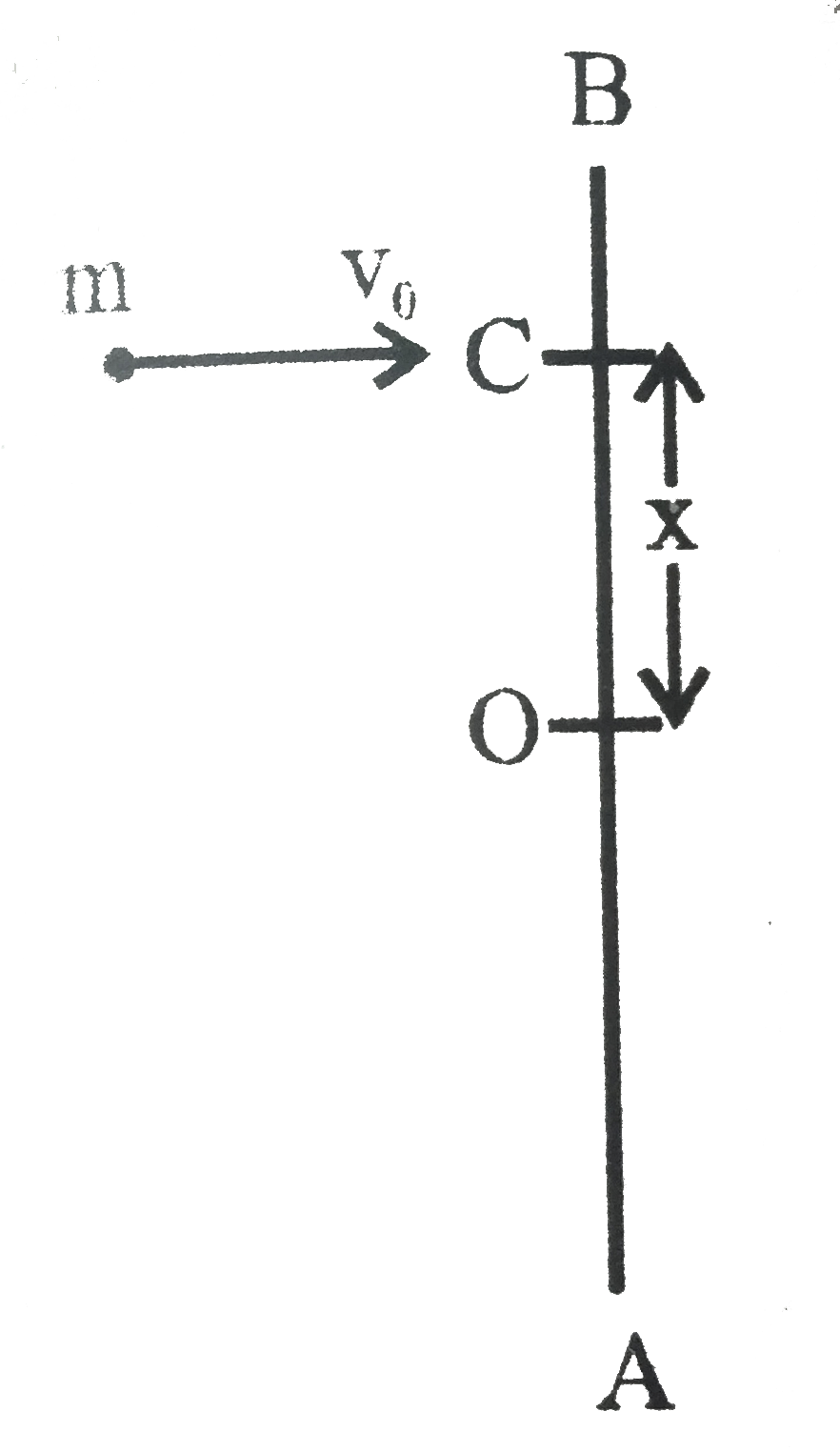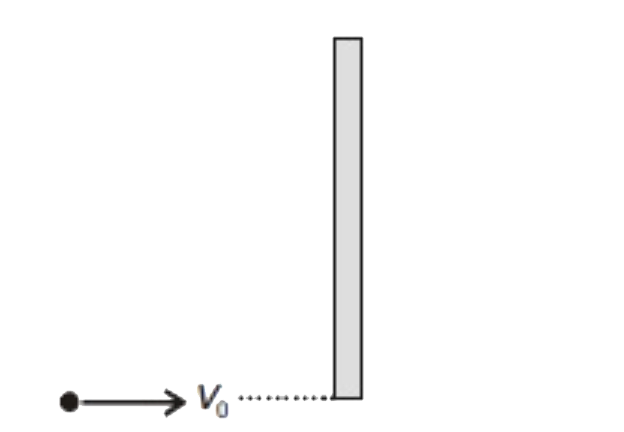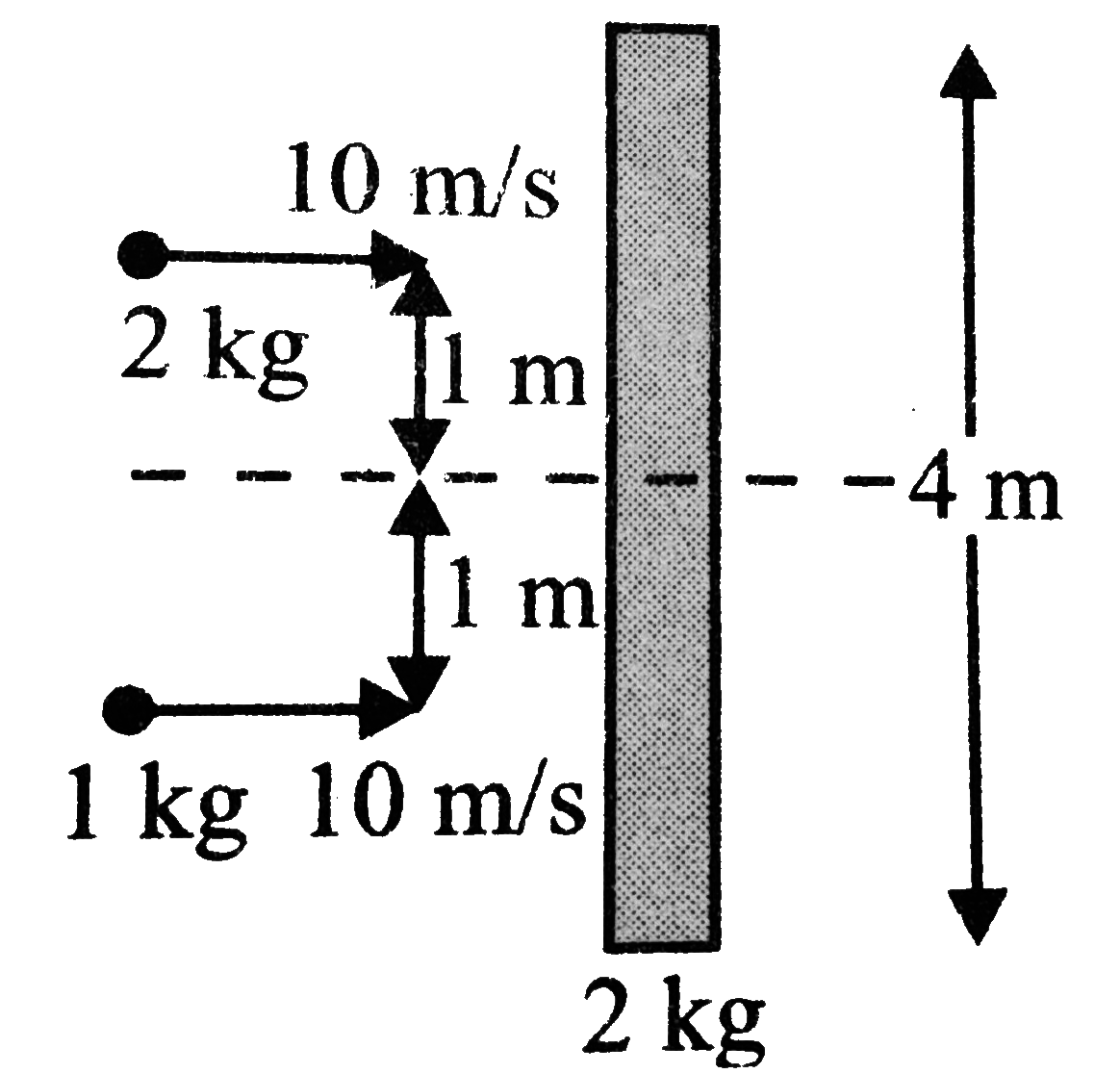A rod of mass m and length l in placed on a smooth table. An another particle of same mass m strikes the rod with velocity in a direction perpendicular to the rod at distance from its centre . Particle sticks to the end. Let be the angular speed of system after collision , then
As x is increased from 0 to l/2 , the angular speed .
will continuously increase
will continuously decrease
will first increase and then decrease
will first increase and then decrease
The correct Answer is:C
To solve the problem, we will analyze the situation using the principles of conservation of angular momentum and the moment of inertia.
1. Understanding the System:
- We have a rod of mass m and length l placed on a smooth table.
- A particle of mass m strikes the rod perpendicularly at a distance x from the center of the rod.
- The particle sticks to the end of the rod after the collision.
2. Initial Angular Momentum:
- The initial linear momentum of the particle before the collision is mv0.
- The distance from the center of the rod to the point of impact is x.
- Therefore, the initial angular momentum Li about the center of the rod is given by:
Li=mv0⋅x
3. Final Angular Momentum:
- After the collision, the system (rod + particle) will rotate about the center of mass.
- Let ω be the angular speed of the system after the collision.
- The moment of inertia I of the rod about its center is:
Irod=13ml2
- The moment of inertia of the particle (considered as a point mass at a distance l2 from the center) is:
Iparticle=m(l2)2=ml24
- The total moment of inertia If of the system after the collision is:
If=Irod+Iparticle=13ml2+ml24
- To combine these, we find a common denominator (12):
If=4ml212+3ml212=7ml212
4. Applying Conservation of Angular Momentum:
- According to the conservation of angular momentum:
Li=Lf
- Therefore:
mv0⋅x=If⋅ω
- Substituting If:
mv0⋅x=7ml212⋅ω
- Canceling m from both sides:
v0⋅x=7l212⋅ω
- Solving for ω:
ω=12v0⋅x7l2
5. Analyzing ω as x varies:
- As x increases from 0 to l2:
- When x=0:
ω=0
- When x=l4:
ω=12v0⋅l47l2=3v07l
- When x=l2:
ω=12v0⋅l27l2=6v07l
- Since 3v07l<6v07l, we conclude that ω increases as x increases from 0 to l2.
Conclusion:
As x increases from 0 to l2, the angular speed ω of the system increases.
- We have a rod of mass m and length l placed on a smooth table.
- A particle of mass m strikes the rod perpendicularly at a distance x from the center of the rod.
- The particle sticks to the end of the rod after the collision.
- The initial linear momentum of the particle before the collision is mv0.
- The distance from the center of the rod to the point of impact is x.
- Therefore, the initial angular momentum Li about the center of the rod is given by:
Li=mv0⋅x
- After the collision, the system (rod + particle) will rotate about the center of mass.
- Let ω be the angular speed of the system after the collision.
- The moment of inertia I of the rod about its center is:
Irod=13ml2
- The moment of inertia of the particle (considered as a point mass at a distance l2 from the center) is:
Iparticle=m(l2)2=ml24
- The total moment of inertia If of the system after the collision is:
If=Irod+Iparticle=13ml2+ml24
- To combine these, we find a common denominator (12):
If=4ml212+3ml212=7ml212
- According to the conservation of angular momentum:
Li=Lf
- Therefore:
mv0⋅x=If⋅ω
- Substituting If:
mv0⋅x=7ml212⋅ω
- Canceling m from both sides:
v0⋅x=7l212⋅ω
- Solving for ω:
ω=12v0⋅x7l2
- As x increases from 0 to l2:
- When x=0:
ω=0
- When x=l4:
ω=12v0⋅l47l2=3v07l
- When x=l2:
ω=12v0⋅l27l2=6v07l
- Since 3v07l<6v07l, we conclude that ω increases as x increases from 0 to l2.
As x increases from 0 to l2, the angular speed ω of the system increases.
Topper's Solved these Questions
- ROTATIONAL MOTIONBOOK - DC PANDEY ENGLISHCHAPTER - ROTATIONAL MOTIONEXERCISE - Matrix Matching Type Questions
16 Videos
- ROTATIONAL MOTIONBOOK - DC PANDEY ENGLISHCHAPTER - ROTATIONAL MOTIONEXERCISE - Integer Type Questions
17 Videos
- ROTATIONAL MOTIONBOOK - DC PANDEY ENGLISHCHAPTER - ROTATIONAL MOTIONEXERCISE - More than one option is correct
36 Videos
- ROTATIONAL MECHANICSBOOK - DC PANDEY ENGLISHCHAPTER - ROTATIONAL MECHANICSEXERCISE - Subjective Questions
2 Videos
- SEMICONDUCTORS AND ELECTRONIC DEVICESBOOK - DC PANDEY ENGLISHCHAPTER - SEMICONDUCTORS AND ELECTRONIC DEVICESEXERCISE - More than One Option is Correct
3 Videos
Similar Questions
A rod of mass m and length l in placed on a smooth table. An another particle of same mass m strikes the rod with velocity v0 in a direction perpendicular to the rod at distance x(<l/2) from its centre . Particle sticks to the end. Let ω be the angular speed of system after collision , then
Find the maximum possible value of impulse (by varying x) that can be imparted to the particle during collision. Particle still sticks to the rod.
View SolutionA uniform rod AB of length L and mass M is lying on a smooth table. A small particle if mass m strike the rod with velocity v0 at point C at a distance comes to rest after collision. Then find the value of x, so that point A of the rod remains stationary just after collision.
 .
.
View SolutionA uniform rod of mass m and length L is at rest on a smooth horizontal surface. A ball of mass m, moving with velocity v0, hits the rod perpendicularly at its one end and sticks to it. The angular velocity of rod after collision is

View SolutionA uniform rod of mass M and length l is placed on a smooth- horizontal surface with its one end pivoted to the surface. A small ball of mass m moving along the surface with a velocity v0, perpendicular to the rod, collides elastically with the free end of the rod. Find:
a. the angular velocity of the rod after collision.
b. the impulse applied by the pivot on the rod during collision. (Take M/m=2)

View SolutionA rod AB of length 2L and mass m is lying on a horizontal frictionless surface. A particle of same mass m travelling along the surface hits the rod at distance L2 from COM with a velocity v0 in a direction perpendicular to rod and sticks to it.

Angular velocity of rod just after collision is
View SolutionA rod AB of length 2L and mass m is lying on a horizontal frictionless surface. A particle of same mass m travelling along the surface hits the rod at distance L2 from COM with a velocity v0 in a direction perpendicular to rod and sticks to it.

Angular velocity of rod just after collision is
View SolutionA Iong slender rod of mass 2kg and length m is placed on a smooth horizontal table. Two particles of masses 2kg and 1kg strike the rod simultaneously and stick to the rod after collision as shown in fig.

Velocity of the centre of mass of the rod after collision is
View SolutionA uniform rod of mass m, length l rests on a smooth horizontal surface. Rod is given a sharp horizontal impulse p perpendicular to the rod at a distance l/4 from the centre. The angular velocity of the rod will be
View SolutionThe radius of gyration of a uniform rod of mass m and length l about an axis perpendicular to its length and at distance l4 from its centre will be
View SolutionA uniform rod of mass 2kg and length 1m lies on a smooth horizontal plane. A particle of mass 1 kg moving at a speed of 2ms−1 perpendicular to the length of the rod strikes it at a distance 14 m from the centre and stops . Find the angular velocity of the rod about its centre just after the collision (in rad/s)
View Solution
